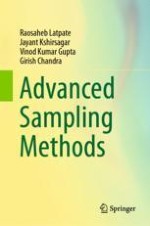
2021 | OriginalPaper | Chapter
1. Introduction
Authors : Raosaheb Latpate, Jayant Kshirsagar, Vinod Kumar Gupta, Girish Chandra
Published in: Advanced Sampling Methods
Publisher: Springer Singapore
Activate our intelligent search to find suitable subject content or patents.
Select sections of text to find matching patents with Artificial Intelligence. powered by
Select sections of text to find additional relevant content using AI-assisted search. powered by